This is the third of a series of articles devoted to the recent Toronto film festival (September 10-19).
The seven-year artistic collaboration between Israeli Yaron Shani and Palestinian Scandar Copti produced one of the Toronto film festival’s most important and courageous fiction films, Ajami. In this portrait of Jaffa’s largest Arab neighborhood, Ajami, the filmmakers attempt to capture the violence and irrationalism that plague present-day Israeli society.
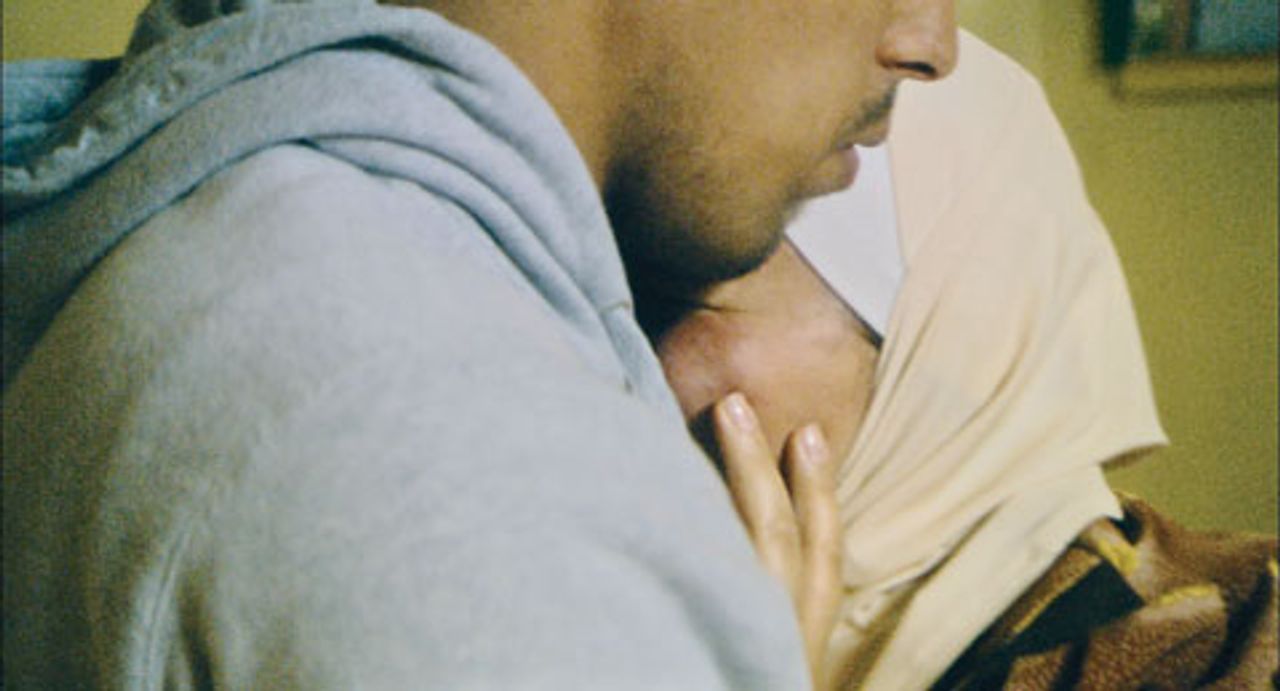 Ajami
AjamiDividing Ajami into four chapters, Copti and Shani tell interlinked stories, primarily through the words and drawings of 13-year-old Nasri (Fouad Habash). In the film’s shocking opening sequence, a teenage Palestinian is shot dead while tinkering with his car. The deceased is Nasri’s neighbor and the bullet was intended for Nasri’s older brother Omar (Shahir Kabaha), in retribution for a shooting at his uncle’s café.
Brokering a deal on Omar’s behalf is Abu Elias (Youssef Sahwani), the wealthy Christian-Arab owner of most of the neighborhood’s businesses who functions as the community’s ‘Godfather.’ The negotiations between the parties are rife with corruption and religious obscurantism, and end up bankrupting Omar’s family.
Malek (Ibrahim Frege), a teenaged Palestinian from the Occupied Territories, works illegally in a restaurant in Ajami. He is desperate to raise money for a life-saving medical procedure for his mother. Teaming up with Omar, the duo get in over their heads in a drug sale manipulated by Abu Elias. The latter is working with Israeli policeman Dando (Eran Naim), a solid family man whose hatred for Arabs turns homicidal when his younger brother, a soldier missing in action, is found murdered.
Binji (Copti), the unwitting trigger for the narcotics operation, is a Palestinian whose life is cut short before he can fulfill his ambition of marrying his Jewish girlfriend and escaping Ajami—“the impossible dream.”
Ajami is a complex, deep-going work. The performers are all non-professionals, and, as the directors explain, come from tough backgrounds, “where violence and crime are part of everyday life.” The notion that “reality can be stronger and more interesting than imagination” animated the artistic exploration during 10 months of preparatory workshops with the actors. After describing the arduousness of the process, Shani states in the film’s production notes: “For a moment, their [the actors’] minds believed that what was happening was real. The emotions that came out of it exceeded our wildest imagination.” (The film’s first assembly had 40 hours of multi-camera footage.)
Ajami’s passion stems in part from the desire for an end to a horrific state of affairs. Nonetheless, the depiction of the participants in the conspiratorial and mutually beneficial relationship between the Israeli police force and Arab elite—one of the film’s principal concerns—avoids oversimplification. Beyond that, there is no respite in the movie from the tensions, anxieties, and poverty that beset Israeli society. These ills are grasped and presented by the filmmakers as fundamentally economic and social, not religious or ethnic, in nature, making Ajami an unusual and powerful work.
A History of Israeli Cinema
A History of Israeli Cinema, a two-part documentary by French-born, Israeli filmmaker Raphaël Nadjari, looks chronologically at Jewish or Israeli filmmaking starting from 1932 through 2005. Interviews with filmmakers, critics and academics are supplemented by extensive film clips in the 210-minute documentary.
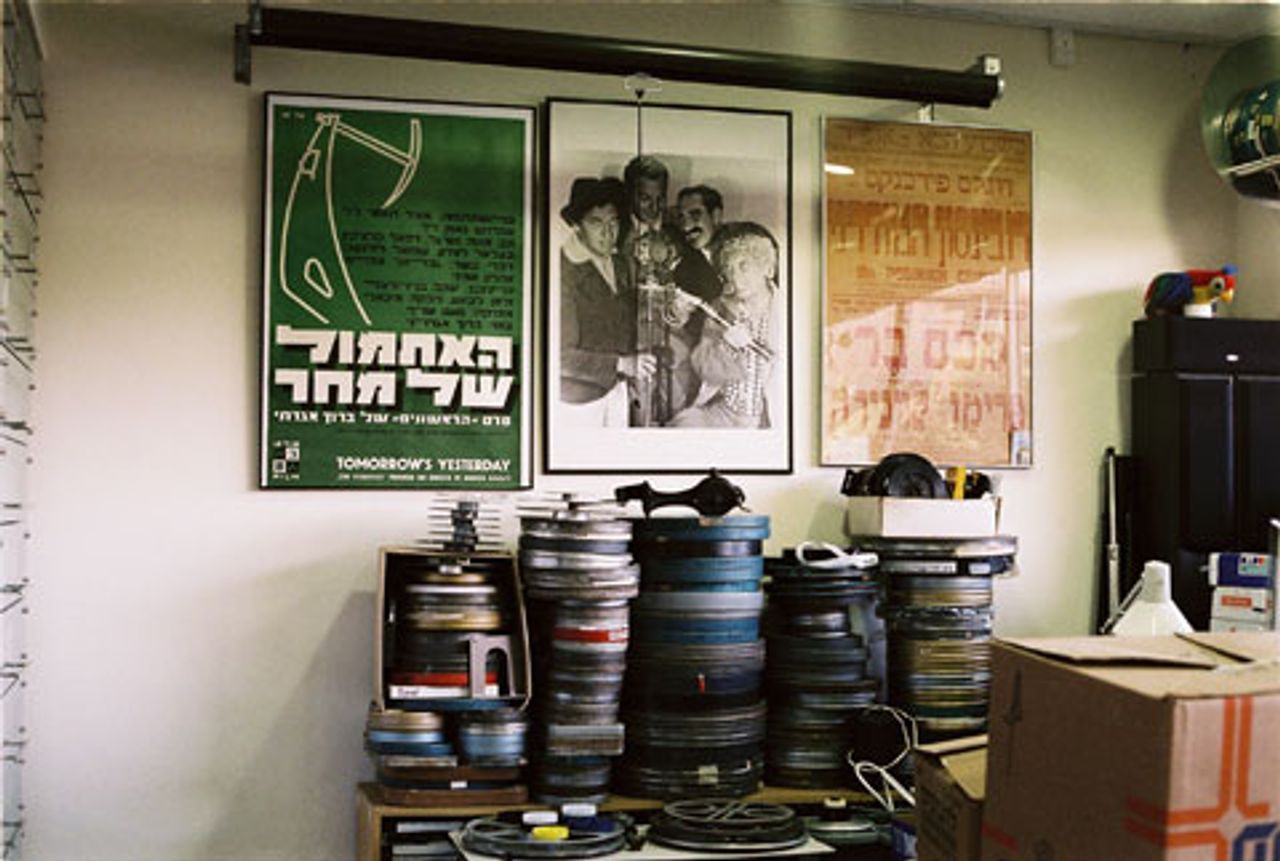 A History of Israeli Cinema
A History of Israeli CinemaAlthough not vast as a body, Israeli cinema has for the most part been highly ideological, reflecting in various ways the artificial nature of the foundations of the Zionist state. In the early 1930s, films such as Oded the Wanderer and The Pioneer by Nathan Axelrod—who came from the Soviet Union in 1926—were propaganda pieces hoping to attract emigration from the European Diaspora through images of the heroic pioneer who represents the organic, permanent Jewish bond with the land of Israel. The hero as fighter replaces the pioneer after the declaration of nationhood in 1948.
Films made after the 1967 war promote the sentiment that militarism may be able to overcome political problems. According to Ella Shohat’s Israeli Cinema: East/West and the Politics of Representation, post-1967 films continue to reinforce the earlier traditional representation of the cruel Arab “tyrant.” Some of these “heroic-nationalist films” were shot in English (Five Days in Sinai, Maurizio Lucida, 1969). “The unequal and artificial dichotomy of Israelis speaking in English and Arab, Arabic, reinforces the identification of Israel with the West, particularly the United States.”
From 1967 to 1977, “bourekas” films dominated and gave expression to Sephardic-Ashkenazi tensions (The House of Chlouch Street, Moshé Mizrahi, 1973). Shohat writes that the post-1967 war period “brought a degree of economic mobility for Sephardim (partially facilitated by the availability of cheap Arab labor from Gaza and the West Bank), but it also deepened the social and economic gap between the two major Jewish ethnic groups. …
“‘Bourekas’ escapism derives from the almost utopian desire to bridge the gaps of Israeli society, and thus promote an image of ethnic/class equality, pluralistic tolerance, and solidarity.” The highly successful Sallah Shabbati (Ephraim Kishon, 1964) was considered to be the quintessential “bourekas” film and is set in the 1950s during the era of mass immigration. At the same time, Uri Zohar’s A Hole in the Moon (1965) was representative of a less conventional cinema dubbed the New Sensibility.
In the 1970s and 1980s films such as The Paratroopers (1977) by Yehuda Ne’eman begin to undercut nationalist-heroic myths and reference more difficult political topics, such as the Arab/Jewish relationship. Israeli films had previously assumed the conflict as a given. The rise of Likud in 1977 engendered an oppositional spirit in films that heightened with the brutal Israeli invasion of Lebanon in 1982.
For example, Avanti-Popolo (Raffi Bukai, 1986) dramatizes the 1967 war from an Arab perspective, using for that purpose the Shylock speech from Shakespeare’s A Merchant of Venice (“If you prick us, do we not bleed?”) and the Oscar-winning film Beyond the Walls (Uri Barabash, 1984) concerns itself with a recognition of the legitimacy of the Palestinian cause. In fact, in the documentary one of the few voices on behalf of the Palestinians is provided by actor Muhammad Bakri, who narrates clips from the Barabash film in which he starred.
Nadjari’s History ends by touching upon a later cinema that reflects the failure of the Zionist project (for example, Life According to Agfa, the 1992 film by Assi Dayan—son of Moshe Dayan) and interviews current Israeli filmmakers, such as Amos Gitai and Avi Mograbi. Noticeably absent are the films of such Palestinian luminaries Hany Abu Assad and Elia Suleiman. Nadjari’s approach, while serious, is insufficiently critical or historically informed to provide the spectator with the perspective on the subject he or she truly needs.
The Time that Remains
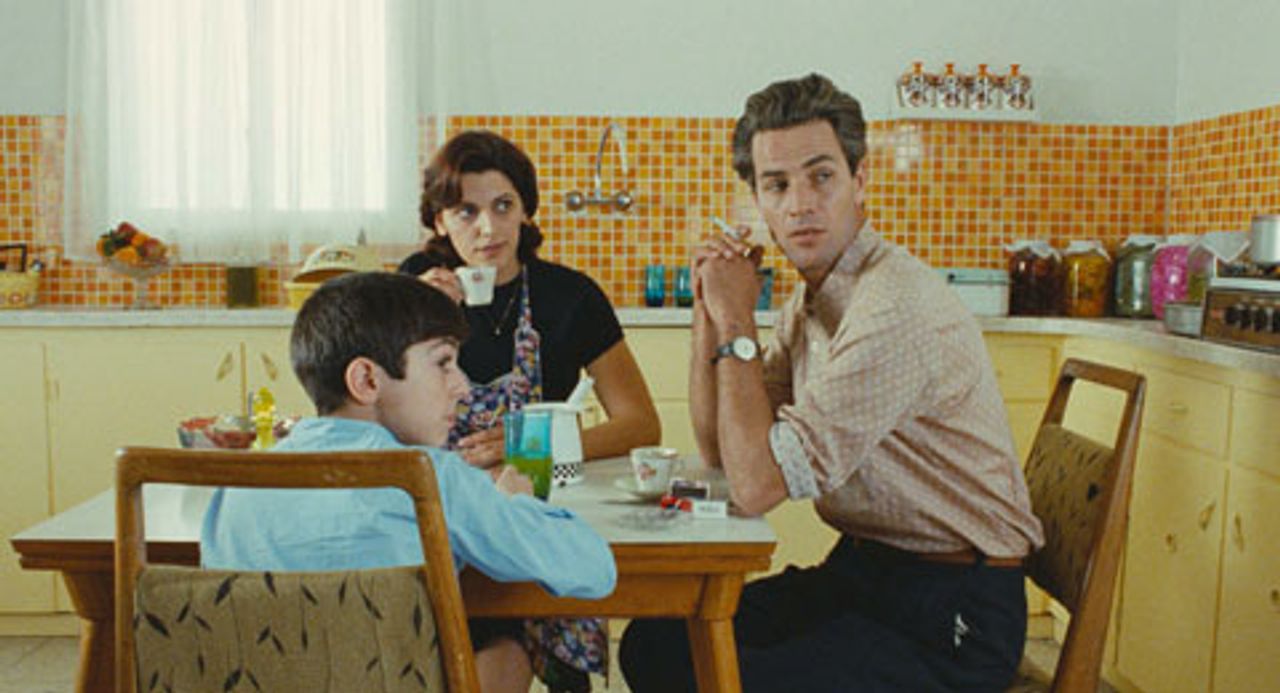 The Time That Remains
The Time That RemainsElia Suleiman’s new film, The Time That Remains is a satirical, semi-autobiography in four episodes beginning in 1948, when the Zionist militia invaded his hometown of Nazareth. Suleiman’s father was a resistance fighter, whose history and that of the filmmaker’s immediate family are recounted with a soulful, ironic bent.
Intimate memories, based on the diaries of his father (played by Saleh Bakri, son of Muhammad Bakri), are presented surrealistically and record the uneven battle between Palestinians, who were virtually defenseless as they fought against a military, trained and equipped by the British.
As the director explains: “The resistance was made up of neighbors and villagers, whose weapons were shotguns used for hunting or for protecting their land, whereas the Haganah [Zionist paramilitary organization] were working from a plan which had been prepared in advance. Intelligence reports had been made in every village, taking advantage of the inhabitants’ hospitality and trust. When they arrived they already had all the names of the anti-colonialists, the nationalists, the left-wing activists—anyone who was politically motivated. And they carried out numerous summary executions based simply on these lists.”
The Time That Remains condenses historical events in a highly personal manner that incorporates the filmmaker’s emotional response, albeit deliberately distanced, to the episodes being recounted. Events are stylized, almost theatrically staged.
Towards the film’s beginning, three elderly men sit outside a Nazareth café. It is brilliantly sunny as the Israeli occupation begins. One hapless fighter, an Iraqi, announces himself a member of the “Arab Liberation Army” and asks for directions to Tiberias. He heads off. Later, he appears again, presumably coming from Tiberias, and asks the three men the way to Haifa. It is an absurd but telling and poignant moment.
As the Israeli presence becomes permanent and popular resignation sets in, the Suleimans take on the characteristic of floating atoms, or disembodied spirits.
The tragedy of the Palestinians flows through the film’s quirky humor. Young Elia attends a school where the Arab students are forced to sing patriotic Israeli songs in Hebrew. He apparently comes into opposition. We see the imposing director reprimanding the small boy, demanding to know: “Who told you America is imperialist?”
Hospital sequences are the most offbeat. Death is more present than life; gurneys more numerous than beds; silence more subversive than language. In this way, the plight of the Palestinians is handled, as Suleiman says, in a non-fetishistic and universal manner—“the world itself becomes Palestine.”
The filmmaker plays himself with a Buster Keaton-esque deadpan. His voyeuristic, flat presence at times has a self-conscious, irritating quality. But there is perhaps a point. In the film’s production notes, Suleiman talks about the pleasure of “otherness” of “living in others’ skins, of all colors ... This is when your poetry becomes truthful and sincere.”
There may another element: Nazareth was part observer to the nightmarish events of 1948. “Nazareth was more or less spared at the time for very precise historical reasons,” says Suleiman. Ben Gurion had asked the Haganah to “avoid Nazareth because of its churches: he knew the bells would be heard all the way to the Vatican, thus exposing them to the entire world.” He goes on to say that each “building, each village you see today has been built on the ruins of another.” This historical memory permeates the remarkable Suleiman film.
Carmel
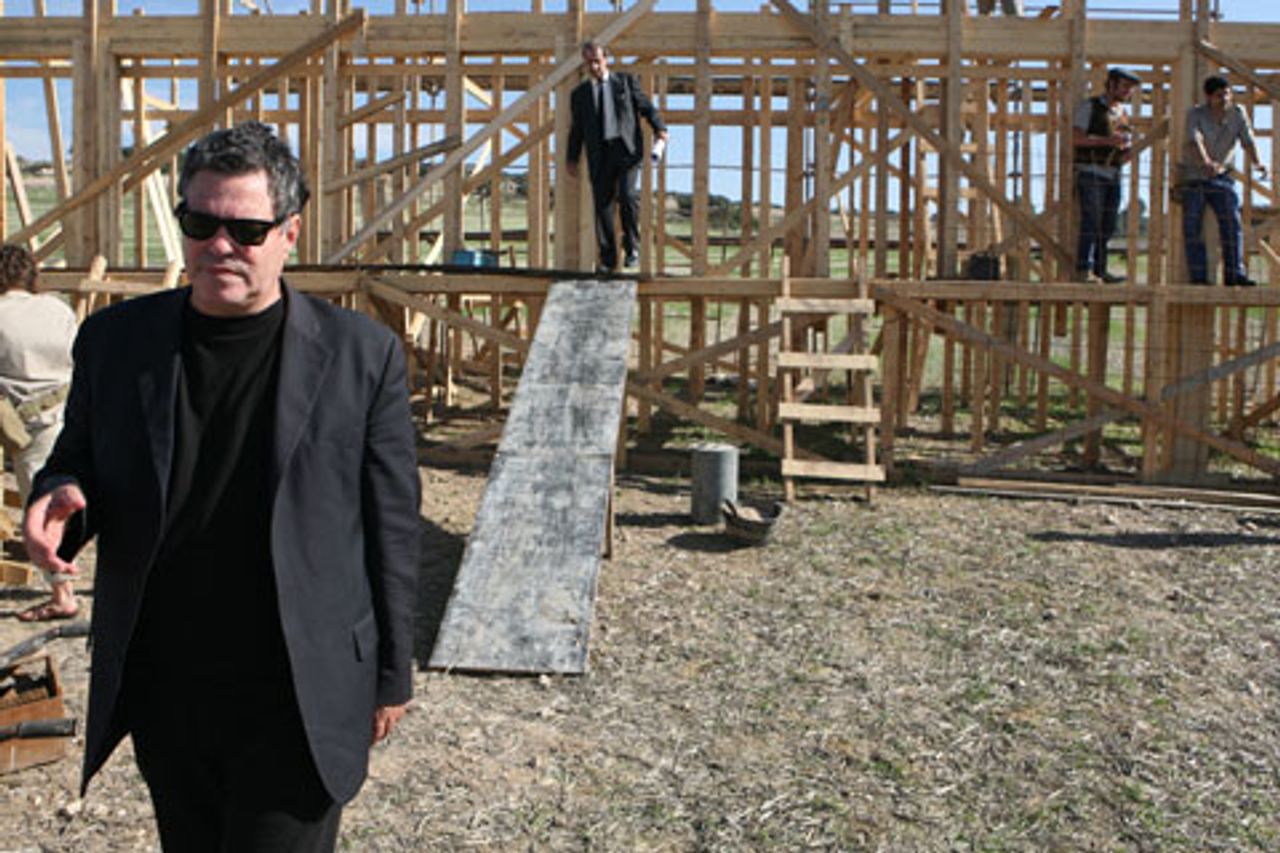 Carmel
CarmelVeteran Israeli director Amos Gitai’s Carmel opens with several shots of the filmmaker walking on a beach. He is apparently tortured and angst-ridden. This atmosphere pervades the film.
In the course of Carmel Gitai worries about his son who is a soldier. There are also close-ups of his beautiful daughter. There are flashbacks to his childhood on a kibbutz. There are accounts of his experiences as a soldier; he was shot down in a helicopter during the Yom Kippur War. Mostly, there are readings of letters from his mother. In fact, the film is an homage to his mother who died five years ago.
It has been a while since Gitai, a talented and influential filmmaker, has been able to get out of himself. His films increasingly lack spontaneity and vitality. Whatever personal and artistic issues may be involved, there is little doubt that a central problem remains his refusal to confront directly the disaster that Zionism has proven to be, for Arabs and Jews alike.
City of Life and Death
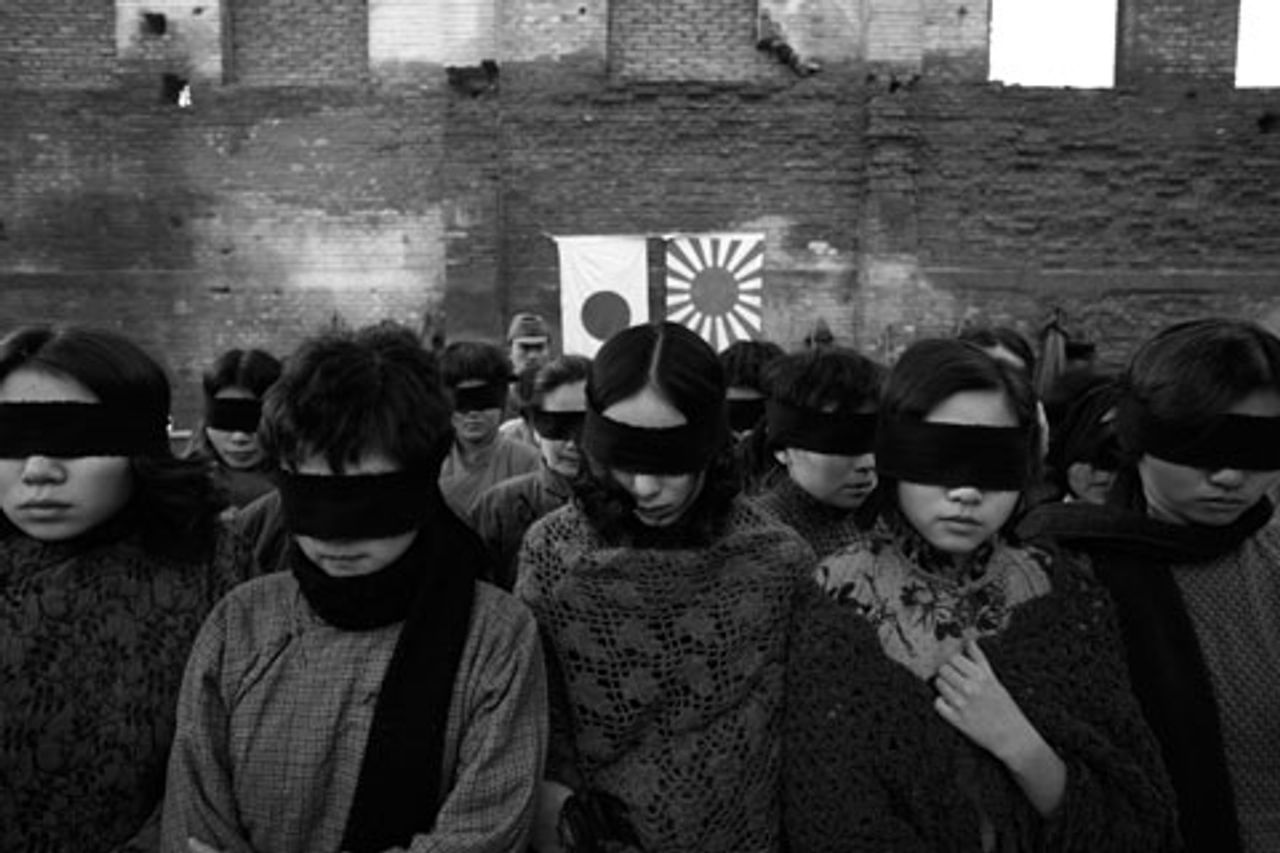 City of Life and Death
City of Life and DeathChinese director Lu Chuan’s City of Life and Death deals with the Nanking massacre, in which hundreds of thousands of civilians were murdered, during the Japanese invasion of China in December 1937. The 135-minute, black and white fiction film is very detailed and focuses on a few real-life characters: a young Japanese soldier who becomes deeply traumatized; a Chinese collaborator who eventually plays an honest role; a German businessman who attempts to save the lives of the victims of the occupation; some of the Chinese and Japanese women forced into prostitution.
Great effort and care has gone into recreating what is known as the Rape of Nanking. Lu has without doubt poured himself into the enterprise. “Lu Chuan led us through a journey of hell,” said one of the actors in an interview. Unfortunately, the movie is overwrought, and all incidents are treated equally regardless of historical weight. Perspective is lacking and essential elements are rarely separated from the secondary.
To be continued
